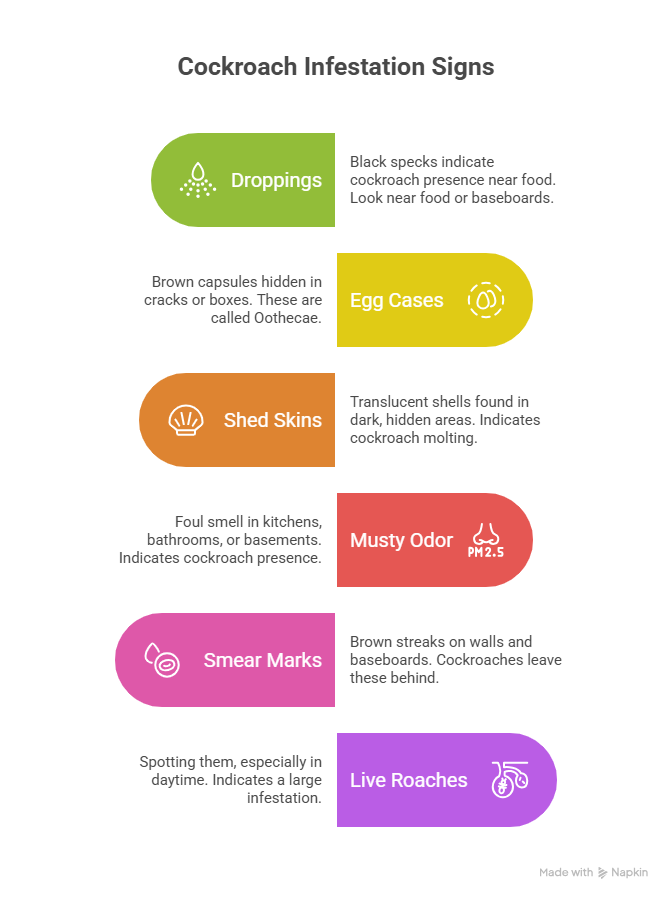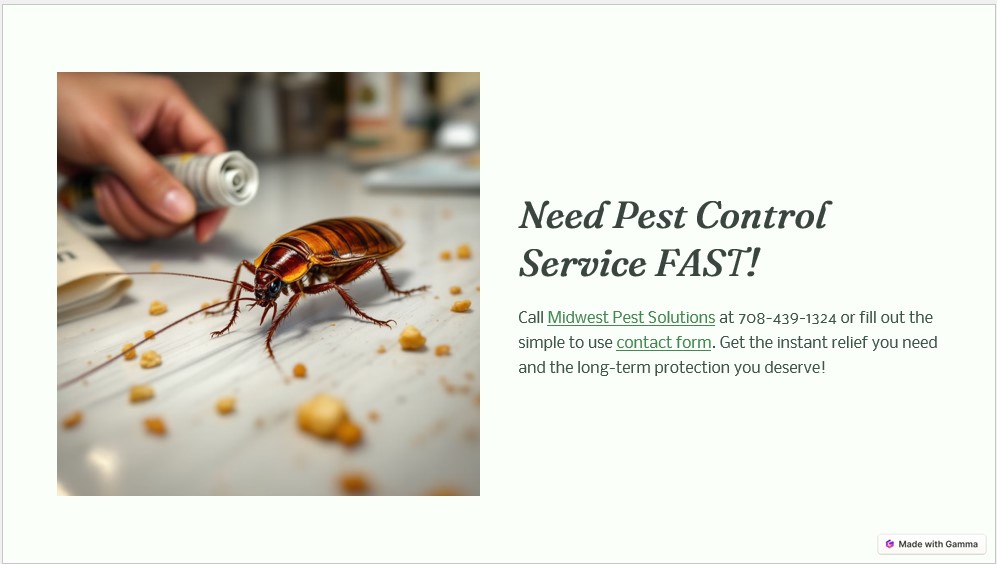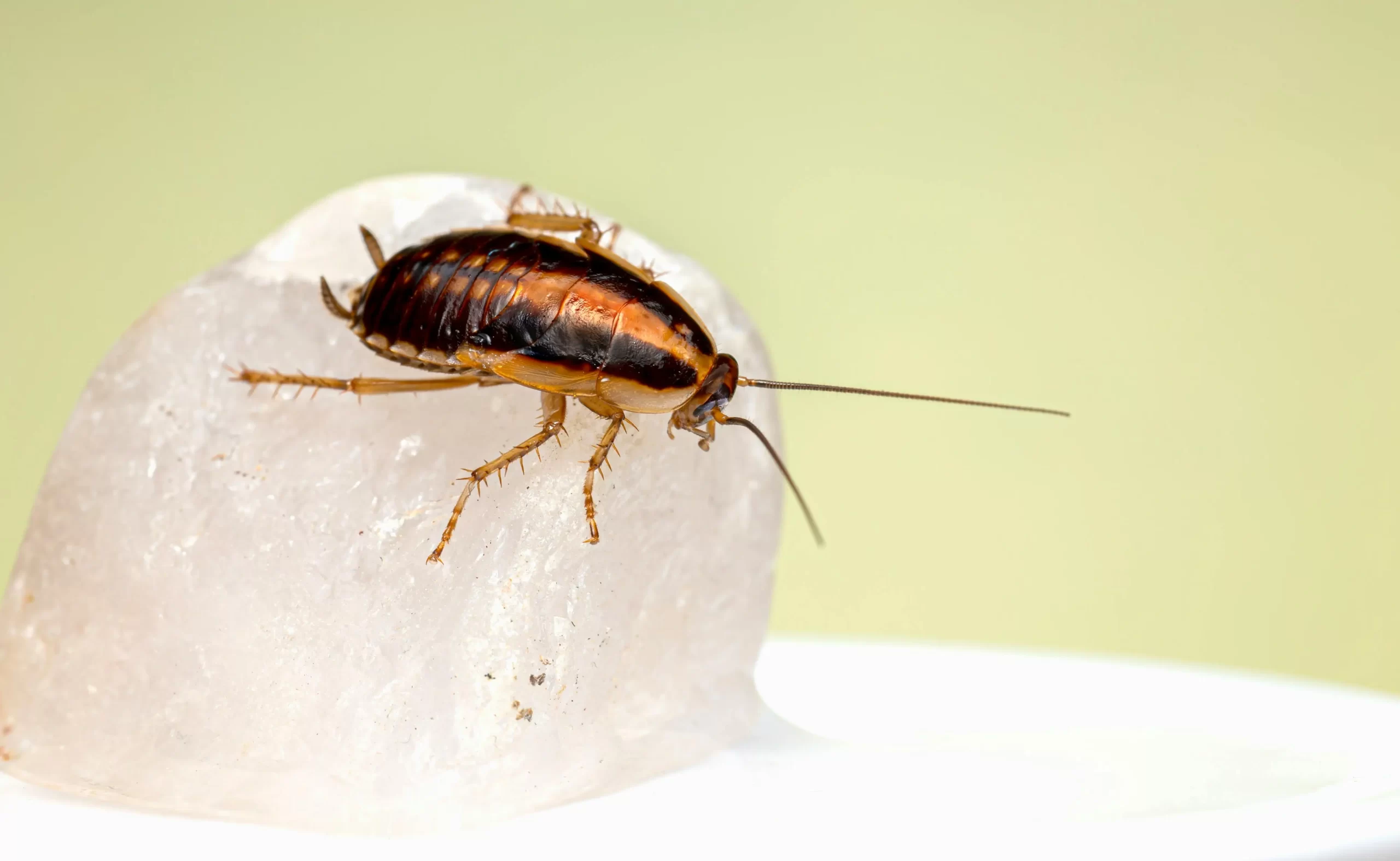Cockroaches are the ultimate survivalists. In bustling cities like Chicago and Oak Lawn, Illinois, they can squeeze through the tiniest cracks, breed rapidly, and go unnoticed until their numbers explode. By the time most people realize they have a problem, it’s already a full-blown infestation. But here’s the good news: you can beat them at their own game—if you know what to look for.
Early detection is your greatest weapon against these nocturnal intruders. In this comprehensive guide, we’ll uncover the telltale signs of a cockroach infestation in its early stages—before these uninvited guests overrun your kitchen, bathroom, and pantry. Let’s dive in and learn how to stay one step ahead.
🏠 Why Early Detection is Essential
Before we get into the nitty-gritty of cockroach clues, it’s crucial to understand why early detection matters. Cockroaches aren’t just unsightly; they’re vectors of disease. According to the Illinois Department of Public Health, these pests can spread salmonella, E. coli, and other harmful bacteria. Their droppings and shed skins can also trigger allergies and asthma, particularly in children and the elderly.
The faster you act, the easier and cheaper it is to eradicate the problem. Once a colony takes hold, professional pest control becomes not just an option, but a necessity. That’s why the experts at Midwest Pest Solutions always stress the importance of early detection—because once you see the signs, it’s time to take action.
🪳 The First Clue: Cockroach Droppings
The earliest and often most telling sign of a cockroach infestation? Their droppings. Small, black, and pepper-like, these specks can be found anywhere cockroaches scuttle. Common hiding spots include:
- Kitchen cabinets
- Pantry shelves
- Behind appliances
- Along baseboards and corners
The density of droppings can reveal the severity of your problem. A few here and there might indicate a newly arrived scout, but clusters of droppings? That’s a warning sign that a nest is nearby.
🥚 Egg Cases (Oothecae): A Silent Signal of Growth
Cockroaches don’t just appear out of nowhere; they’re born in clusters—sometimes dozens at a time. Female cockroaches produce oval-shaped egg capsules called oothecae, which are often brown or dark brown in color. Each capsule can contain up to 50 eggs, meaning that if you spot one, you’re likely dealing with an active and growing population.
Where should you be looking? Here’s where these egg cases typically hide:
- Cracks and crevices in walls or furniture
- Inside cardboard boxes
- Behind kitchen appliances
- In cluttered storage spaces like basements and attics
Finding even one ootheca is a red flag—cockroaches are actively breeding in your space.
🪞 Shed Skins: Nature’s Warning Sign
Cockroaches, like many insects, molt as they grow. Each shedding leaves behind a translucent shell-like skin. These shed skins can be a dead giveaway that young nymphs are maturing and your infestation is on the rise.
Look for these papery, ghostly remains in:
- Dark, quiet corners of your kitchen or bathroom
- Inside cupboards and drawers
- Around plumbing fixtures
If you’re seeing more than one, it’s time to get proactive about the next steps.
🌫️ Musty or Oily Odors: Smell the Warning
Sometimes, your nose knows best. Cockroach infestations often come with a distinctive smell—musty, oily, and distinctly unpleasant. This odor is produced by the cockroaches’ scent glands and becomes more pronounced as the infestation grows.
If you walk into your kitchen, bathroom, or basement and catch a whiff of something foul, don’t ignore it. Even a faint smell can be an early indicator that these pests are making themselves at home.
🟤 Smear Marks: Moisture Meets Movement
In areas with high humidity—like kitchens and bathrooms—cockroaches leave behind greasy brown smear marks as they travel. These marks are most common in places where they crawl along the same path repeatedly, such as:
- Along baseboards
- Around sink pipes
- Near water sources
These telltale smudges are often overlooked, but they’re one of the earliest signs that roaches are active and comfortable in your space.
🔎 Where to Look: Hotspots for Early Signs
To catch an infestation early, you need to think like a roach. These pests love dark, damp, and hidden places. Here’s your checklist of hotspots:
- Under sinks – Moisture and darkness make this a prime cockroach real estate.
- Behind the fridge and stove – Food scraps and warmth attract them here.
- Inside cabinets and drawers – Crumbs and food spills are a feast for these insects.
- Basements and utility rooms – Dampness and clutter are an irresistible combo.
- Pantries and food storage areas – Easy access to food means easy breeding grounds.
🚨 Why It’s So Important to Act Quickly
Seeing early signs like droppings, egg cases, or shed skins might seem like a minor annoyance—but they’re anything but. Cockroaches multiply rapidly and adapt to almost any environment. Ignoring these early clues allows them to expand their territory, turning your home or business into a full-blown infestation zone.
Once an infestation takes hold, DIY treatments often fall short. Professional pest control services, like Midwest Pest Solutions, offer the thorough inspection and targeted treatments needed to break the cycle and keep these pests at bay.
💡 Early Signs of Cockroach Infestation


| Sign | Description & Where to Look |
| Droppings | Black specks like pepper or coffee grounds, near food or baseboards |
| Egg Cases (Oothecae) | Brown/dark capsules hidden in cracks or boxes |
| Shed Skins | Translucent shells in dark, hidden areas |
| Musty/Oily Odor | Foul smell in kitchens, bathrooms, or basements |
| Smear Marks | Brown streaks on walls and baseboards |
| Live/Dead Roaches | Spotting them, especially in daytime |
Citation:
Illinois Department of Public Health: Cockroaches and Public Health
In the next section, we’ll explore how to confirm these early signs with practical tips and actionable advice—plus, why Midwest Pest Solutions is the trusted partner for eliminating infestations before they spiral out of control. Stay tuned!
🕵️♂️ Section 2: How to Confirm an Early Cockroach Infestation—Your Action Plan
You’ve spotted the clues: a scattering of black specks under the sink, a lingering oily odor in the pantry, or the unsettling presence of translucent shed skins. Now what? Identifying early signs of a cockroach infestation is only the first step. Next comes confirming the problem and taking swift action before it spirals out of control.
Here’s your step-by-step plan to confirm whether you’re dealing with a burgeoning cockroach colony—and what to do about it.
🔎 Step 1: Conduct a Thorough Visual Inspection
Start by putting on your detective hat and doing a room-by-room visual inspection. Focus on the hot zones we outlined in Section 1: kitchens, bathrooms, basements, and utility rooms. Don’t just look around—dig deep.
- Behind and under appliances – Cockroaches love the warmth behind fridges and stoves.
- Inside cabinets and drawers – Check for droppings and egg cases in corners.
- In cracks and crevices – Grab a flashlight and peek into those dark, forgotten spaces.
- Near water sources – Moisture is a magnet for cockroach activity.
Pro tip: Keep an eye out for movement. Cockroaches are nocturnal, so consider doing your inspection at night. Flip on the lights suddenly—you might catch them scurrying for cover.
🪤 Step 2: Set Up Sticky Traps or Monitors
Seeing is believing, and sticky traps are your silent sentinels. Place them in strategic locations around your home:
- Under sinks and appliances
- Behind the refrigerator
- In dark corners of cupboards
- Along baseboards in the kitchen or bathroom
Check these traps daily. If you’re catching one or two cockroaches, it’s a sign of an early problem. If you’re pulling out traps full of squirming insects? Time to bring in the professionals.
🔍 Step 3: Listen to the Sounds of an Infestation
Yes, you read that right—cockroaches can be noisy! In quiet environments, especially at night, you might hear faint rustling or tapping sounds. These noises come from their movement through walls, under floorboards, or in hidden recesses.
While it’s not the most reliable indicator, it’s another piece of evidence that adds to the puzzle.
🥡 Step 4: Check for Signs of Food Contamination
Cockroaches are scavengers, and they’re not picky. Look for:
- Chewed cardboard or paper packaging
- Droppings near food containers
- Sticky residue or grease marks near pet food dishes
If you find any of these signs, it’s a clear warning: cockroaches are feasting in your kitchen.
💼 Step 5: Evaluate Your Surroundings—The Bigger Picture
Cockroach infestations don’t happen in a vacuum. Consider what might be attracting them in the first place:
- Crumbs and spills – Even a few food scraps can lure cockroaches in.
- Leaky pipes or dampness – Moisture is essential for roaches to thrive.
- Clutter and cardboard boxes – These provide hiding spots and breeding grounds.
Addressing these environmental factors not only helps confirm an infestation but can also prevent it from getting worse.
🚀 Step 6: Call in the Experts—Professional Confirmation
Sometimes, despite your best efforts, it’s hard to be certain. That’s when you need a professional inspection. At Midwest Pest Solutions, experienced technicians don’t just look for the obvious signs—they know exactly where these pests hide and how to flush them out.
Professional pest control services come with several advantages:
- Advanced inspection tools – Thermal imaging, moisture meters, and specialized traps catch what your flashlight might miss.
- Species identification – Different cockroach species require different treatment strategies.
- Safe and effective plans – Targeted treatments and long-term solutions keep your property roach-free.
🧹 Step 7: Take Immediate Preventive Measures
Even while you’re waiting for a professional inspection, there’s plenty you can do:
- Clean thoroughly – Eliminate crumbs, spills, and food residue.
- Seal entry points – Use caulk to seal gaps around pipes, windows, and doors.
- Reduce moisture – Fix leaky pipes and use a dehumidifier in damp areas.
These steps won’t eliminate an established infestation, but they can stop new cockroaches from joining the party.
📝 Why DIY Alone Might Not Cut It
DIY traps and sprays can help confirm activity, but they rarely solve the root of the problem. Cockroaches are expert hiders and prolific breeders. Even if you manage to kill a few, their hidden eggs and breeding adults can keep the cycle going.
That’s why professional intervention is often the only way to truly break the infestation. Midwest Pest Solutions offers comprehensive plans that include:
- Thorough inspections
- Targeted treatments
- Follow-up visits to ensure the problem is completely resolved
💡 Summary Table: Confirming an Early Infestation
| Step | What to Do |
| Visual Inspection | Check hot zones—kitchens, bathrooms, basements—for droppings, egg cases, and skins. |
| Set Sticky Traps | Place them in dark, moist areas and monitor daily. |
| Listen for Sounds | Pay attention to nighttime rustling or scuttling. |
| Check for Food Contamination | Look for signs of gnawing or droppings near food. |
| Evaluate the Environment | Identify moisture issues and clutter that attract roaches. |
| Call in the Pros | Professional inspections find what you can’t see. |
| Immediate Prevention | Clean, seal entry points, and reduce moisture right away. |
🚨 Next Up: Why Professional Intervention is Key
In Section 3, we’ll take a deeper dive into why professional treatments aren’t just a luxury—they’re a necessity when dealing with cockroaches. From targeted insecticides to exclusion work, we’ll cover how Midwest Pest Solutions helps Chicago and Oak Lawn residents reclaim their homes from these persistent pests.
🛡️ Section 3: Professional Intervention—The Key to Eradicating and Preventing Cockroach Infestations
You’ve identified the early signs, confirmed the problem, and taken some preventive measures. But when it comes to cockroaches—some of the most persistent and elusive pests out there—going it alone usually isn’t enough. To truly eliminate an infestation and prevent future headaches, professional pest control is the gold standard.
In this final section, let’s explore why professional treatments are essential, what to expect from a reputable service like Midwest Pest Solutions, and how to keep cockroaches away for good.
🔬 Why DIY Approaches Often Fall Short
DIY traps and sprays can certainly provide temporary relief. But cockroaches are cunning survivors—they’ve been perfecting their craft for millions of years. Even when you think you’ve won, a hidden ootheca (egg case) or an overlooked crack can become ground zero for a fresh infestation.
Cockroaches are also masters of adaptation. Many common sprays only target the visible adults, missing the nymphs and eggs that are the real source of the problem. Plus, improper use of over-the-counter insecticides can actually scatter cockroaches, driving them deeper into walls and hidden spaces.
Professional pest control goes far beyond what’s available at your local hardware store, ensuring that every stage of the cockroach lifecycle is addressed.
💡 The Benefits of Professional Cockroach Treatments
Here’s why bringing in a pro is a game-changer:
🔍 Comprehensive Inspections
Professionals don’t just look for droppings and skins—they know how to find the hidden signs you might miss. Using advanced tools and years of experience, they identify the species of cockroach and the specific areas of your property that are most vulnerable.
🧪 Targeted Treatments
Unlike DIY sprays, professional-grade insecticides and baits are specifically formulated to break the reproductive cycle. These treatments reach deep into the nooks and crannies where cockroaches hide, ensuring thorough elimination.
Companies like Midwest Pest Solutions also tailor their treatments to your specific situation—no generic, one-size-fits-all approaches here.
🛡️ Long-Term Prevention
A key advantage of professional pest control is the focus on exclusion and prevention. Sealing entry points, addressing moisture issues, and removing attractants are all part of a comprehensive plan to keep cockroaches out for good.
🧪 Common Professional Treatments
Here’s what you can typically expect from a professional cockroach treatment plan:
- Bait Stations – These contain slow-acting insecticides that are carried back to the nest, targeting the entire colony.
- Residual Insecticides – Applied in key areas, these keep killing long after the initial treatment.
- Insect Growth Regulators (IGRs) – These disrupt the life cycle of cockroaches, preventing nymphs from reaching adulthood.
- Exclusion Work – Professionals seal up entry points and recommend fixes for leaky pipes and other issues that attract roaches.
This multi-pronged approach doesn’t just kill a few bugs—it targets the entire infestation at every stage of development.
🛑 The Cost of Ignoring the Problem
Delaying professional treatment isn’t just a nuisance—it can be a health hazard. Cockroaches are known carriers of pathogens like salmonella and E. coli, which can contaminate food surfaces and put your family or customers at risk. In fact, as outlined in this public health resource, cockroach infestations are a serious concern for homeowners and businesses alike.
Add to that the cost of repeated DIY attempts that don’t address the root problem, and professional intervention quickly becomes the smart, cost-effective choice.
🏢 Midwest Pest Solutions: Chicago and Oak Lawn’s Trusted Partner
In Chicago and Oak Lawn, residents and businesses have a trusted ally in Midwest Pest Solutions. Their experts bring years of experience and state-of-the-art tools to every job, ensuring that no cockroach goes undetected or untreated.
Here’s why their services stand out:
- Customized treatment plans – No two infestations are alike, and Midwest tailors their approach to your specific needs.
- Safe and eco-friendly options – Your safety is their top priority, with treatments designed to minimize risk to pets and children.
- Ongoing support – Cockroach infestations can reoccur if left unchecked. Midwest offers follow-up visits and maintenance plans to ensure your property stays pest-free.
When you’re dealing with a pest as stubborn as the cockroach, working with a professional like Midwest isn’t just helpful—it’s essential.


🔧 Pro Tips for Prevention After Treatment
Once your home or business has been professionally treated, here’s how you can keep it that way:
- Maintain strict cleanliness – Wipe down counters and floors regularly, and keep food sealed in airtight containers.
- Fix moisture issues – Address leaky pipes and high humidity, as these are magnets for roaches.
- Seal entry points – Cockroaches can squeeze through the tiniest gaps. Caulk and weatherstripping go a long way.
- Declutter – Cardboard boxes, paper bags, and clutter offer perfect hiding spots.
For more prevention tips and expert help, check out Midwest Pest Solutions’ commercial pest control page—they’ve seen it all and can help you stay one step ahead.
📊 Summary Table: Professional Solutions for Cockroach Control
| Treatment | Purpose |
| Bait Stations | Lures and eliminates entire colonies |
| Residual Insecticides | Ongoing protection against new arrivals |
| Insect Growth Regulators (IGRs) | Breaks the breeding cycle of roaches |
| Exclusion Work | Seals entry points and fixes moisture issues |
| Follow-Up Visits | Prevents re-infestation and ensures long-term success |
🏁 Conclusion: Stay Vigilant, Stay Protected
Cockroaches are a formidable foe, but early detection and professional treatment are your secret weapons. By learning the early signs, confirming an infestation, and partnering with trusted pros like Midwest Pest Solutions, you can stop these pests in their tracks and keep your home or business safe, healthy, and roach-free.
Ready to take back control? Contact Midwest Pest Solutions today and let the experts handle it—because when it comes to cockroaches, early action makes all the difference.

